 By dimpled Brook, and Fountain brim, The Wood-Nymphs, deckt with Daisies trim, Their merry wakes and pastimes keep. [FRONTISPIECE] Comus, 1921
By dimpled Brook, and Fountain brim, The Wood-Nymphs, deckt with Daisies trim, Their merry wakes and pastimes keep. [FRONTISPIECE] Comus, 1921 
 Planet Friendly Publishing
Planet Friendly Publishing
 Made in the United States
Made in the United States Printed on Recycled Paper Text: 10% Cover: 10%
Printed on Recycled Paper Text: 10% Cover: 10%
Learn more: www.greenedition.org At Dover Publications were committed to producing books in an earth-friendly manner and to helping our customers make greener choices. Manufacturing books in the United States ensures compliance with strict environmental laws and eliminates the need for international freight shipping, a major contributor to global air pollution. And printing on recycled paper helps minimize our consumption of trees, water and fossil fuels. The text ot Rackhams Fairies, Elves and Goblins was printed on paper made with 10% post-consumer waste, and the cover was printed on paper made with 10% post-consumer waste. According to Environmental Defenses Paper Calculator, by using this innovative paper instead of conventional papers, we achieved the following environmental benefits: Trees Saved: 7 Air Emissions Eliminated: 622 pounds Water Saved: 2,995 gallons Solid Waste Eliminated: 182 pounds For more information on our environmental practices, please visit us online at www.doverpublications.com/green Copyright Copyright 2008 by Dover Publications, Inc.
Text copyright 2008 by Jeff A. Menges All rights reserved. Bibliographical Note This Dover edition, first published in 2008, is an original compilation of illustrations from the following works: Rip Van Winkle (published by William Heinemann, Ltd., London, and Doubleday, Page & Co., 1905); Puck of Pooks Hill (published by Doubleday, Page & Co, 1906); Alices Adventures in Wonderland (published by William Heinemann, Ltd., London, and Doubleday, Page & Co., 1907; The Ingoldsby Legends: or Mirth and Marvels (published by J. M. Dent & Co., London, and Doubleday, Page & Co., 1907); A Midsummer-Nights Dream (published by William Heinemann, Ltd., London, and Doubleday, Page & Co., 1908); Tales from Shakespeare (published by J. M.
Dent & Co., London, and E. P. Dutton & Co., New York, 1907); Undine (published by William Heinemann, Ltd., London, and Doubleday, Page & Co., 1909); Peter Pan in Kensington Gardens (published by Hodder & Stoughton, London, and Charles Scribners Sons, New York, 1912); Aesops Fables (published by William Heinemann, Ltd., London, and Doubleday, Page & Co., 1912); Arthur Rackhams Book of Pictures (published by William Heinemann, Ltd., London, and The Century Co., New York, 1913); Mother Goose. The Old Nursery Rhymes (published by William Heinemann, Ltd., London and New York, 1913); English Fairy Tales (published by Macmillan Company, London and New York, 1918); Some British Ballads (published by Constable & Co., 1918); Comus (published by William Heinemann, Ltd., London, and Doubleday, Page & Co., 1921); and A Wonder Book (published by Hodder & Stoughton, London, and George H. Doran Co., 1922). A new Introduction has been specially prepared for the present edition.
NOTE: Caption punctuation varies according to the original source. Library of Congress Cataloging-in-Publicalion Data Rackham, Arthur, 18671939. Rackhams fairies, elves and goblins : more than 80 full-color illustrations / selected and edited by Jeff A. Menges. p. 9780486133461 1. 9780486133461 1.
Rackham, Arthur, 18671939. 2. Fairies in art. I. Menges, Jeff A. Title. Title.
NC978.S.R32A4 2008 741.64092dc22 2007035597 Manufactured in the United States by Courier Corporation
46023102
www.doverpublications.com Table of Contents
TO JESSICA  INTRODUCTION One of the premier artists of the Golden Age of Illustration (the 1880s through the 1920s), Arthur Rackham was born in London in 1867. He began building his artistic reputation while a student at the City of London School. In his late teens he accepted a clerical position, but he continued to draw and paint, and took up studies at the Lambeth School of Art. Rackhams first forays into the world of professional illustration began when his pieces were included in the Pall Mall Budget weekly, and by 1892 he had committed himself to a full-time artistic career. Exploring a variety of styles early on, Rackham contributed illustrations to various publications for the next few years; his first commissioned work came in 1896. Success built upon success, and soon he was producing images for numerous books and childrens magazines.
INTRODUCTION One of the premier artists of the Golden Age of Illustration (the 1880s through the 1920s), Arthur Rackham was born in London in 1867. He began building his artistic reputation while a student at the City of London School. In his late teens he accepted a clerical position, but he continued to draw and paint, and took up studies at the Lambeth School of Art. Rackhams first forays into the world of professional illustration began when his pieces were included in the Pall Mall Budget weekly, and by 1892 he had committed himself to a full-time artistic career. Exploring a variety of styles early on, Rackham contributed illustrations to various publications for the next few years; his first commissioned work came in 1896. Success built upon success, and soon he was producing images for numerous books and childrens magazines.
His career flourished throughout the early decades of the twentieth century, and he joined the distinguished company of the likes of Walter Crane and Kate Creenawayand proved a leader in new illustration markets and an inspiration for Edmund Dulac and Charles Robinson, among others. After a long and prolific career, Arthur Rackham died in 1939.  Comus, 1921 The works comprising Rackhams Fairies, Elves and Goblins have been selected from sources spanning 1905 to 1922, and include plates from Rackhams landmark success, his illustrations for Washington Irvings Rip Van Winkle. In this 1905 edition, the artist established his penchant and flair for depicting delicately drawn fairies (see Plates 1 and 2 of this Dover edition); grotesque goblins (Plate 3); and mischievous elves (Plate 10); as well as truncated, dwarflike beings (Plate 6). Also included are a vision of an astonishing juxtaposition of realistic human figures with hordes of fairies and elves in Puck of Pooks Hill (Plate 13); a profusely detailed and beautifully colored image of a knight menaced by an ugly dwarf in Undine (Plate 30); the unlikely scene of a plump human child being addressed by a spiky chrysanthemum carrying a plaid umbrella in Peter Pan in Kensington Gardens (Plate 37); and many more expressions of a wondrous world inhabited by both humans and imaginary creatures. What made Arthur Rackham one of the most revered illustrators of the twentieth century was his individuality; his unique and soulful line quality has allowed his work to endure the test of time.
Comus, 1921 The works comprising Rackhams Fairies, Elves and Goblins have been selected from sources spanning 1905 to 1922, and include plates from Rackhams landmark success, his illustrations for Washington Irvings Rip Van Winkle. In this 1905 edition, the artist established his penchant and flair for depicting delicately drawn fairies (see Plates 1 and 2 of this Dover edition); grotesque goblins (Plate 3); and mischievous elves (Plate 10); as well as truncated, dwarflike beings (Plate 6). Also included are a vision of an astonishing juxtaposition of realistic human figures with hordes of fairies and elves in Puck of Pooks Hill (Plate 13); a profusely detailed and beautifully colored image of a knight menaced by an ugly dwarf in Undine (Plate 30); the unlikely scene of a plump human child being addressed by a spiky chrysanthemum carrying a plaid umbrella in Peter Pan in Kensington Gardens (Plate 37); and many more expressions of a wondrous world inhabited by both humans and imaginary creatures. What made Arthur Rackham one of the most revered illustrators of the twentieth century was his individuality; his unique and soulful line quality has allowed his work to endure the test of time.
Coming into his artistic career when line art was used almost exclusively for reproduction, Rackham carried his consummate skills for composition with tone into his color work. It was, however, his line technique that would carry his imagery, and it is this facility that impresses us when we examine his work today. The life and personality that he imparted to his characterizations was an artistic achievement matched by few, if any, of his contemporaries. While Rackham was a skilled line artist who could have taken up more commercial tasksrendering images into line art for newspapers and illustrated magazines of the dayhe had great distaste for working with mundane subjects. Because he did not take a more commercial path, choosing instead to select assignments that reflected his own interest in their subject matter (such as fairy tales or literary works), he was able to put such feeling and personality into his work. Rackhams ability to visually represent the imaginary was far ranging, from the image of the slightest Midsummer fairy (Plate 18) to the intricate, ferocious Dragon of the Hesperides (Plate 48).
Next page
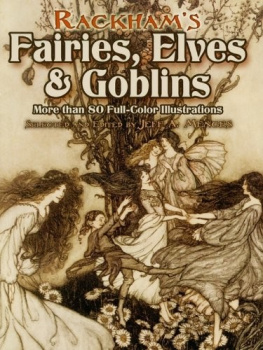
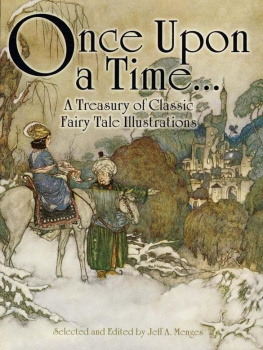
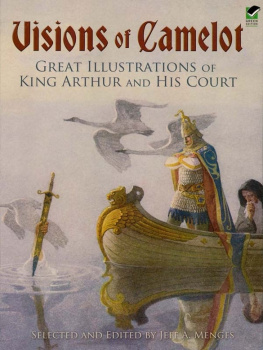




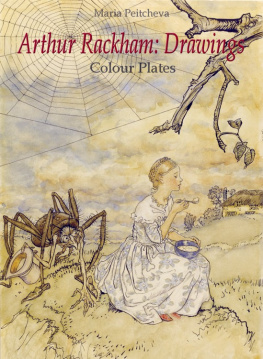
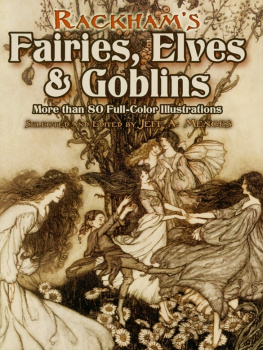
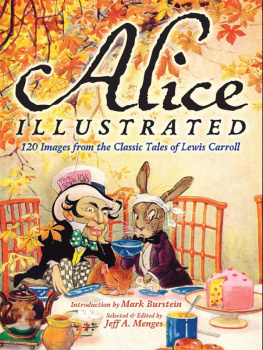
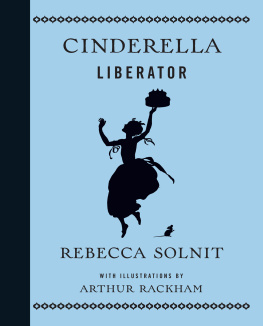

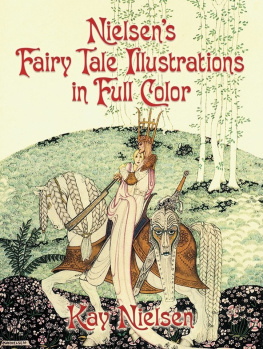

 By dimpled Brook, and Fountain brim, The Wood-Nymphs, deckt with Daisies trim, Their merry wakes and pastimes keep. [FRONTISPIECE] Comus, 1921
By dimpled Brook, and Fountain brim, The Wood-Nymphs, deckt with Daisies trim, Their merry wakes and pastimes keep. [FRONTISPIECE] Comus, 1921 
 Planet Friendly Publishing
Planet Friendly Publishing Made in the United States
Made in the United States INTRODUCTION One of the premier artists of the Golden Age of Illustration (the 1880s through the 1920s), Arthur Rackham was born in London in 1867. He began building his artistic reputation while a student at the City of London School. In his late teens he accepted a clerical position, but he continued to draw and paint, and took up studies at the Lambeth School of Art. Rackhams first forays into the world of professional illustration began when his pieces were included in the Pall Mall Budget weekly, and by 1892 he had committed himself to a full-time artistic career. Exploring a variety of styles early on, Rackham contributed illustrations to various publications for the next few years; his first commissioned work came in 1896. Success built upon success, and soon he was producing images for numerous books and childrens magazines.
INTRODUCTION One of the premier artists of the Golden Age of Illustration (the 1880s through the 1920s), Arthur Rackham was born in London in 1867. He began building his artistic reputation while a student at the City of London School. In his late teens he accepted a clerical position, but he continued to draw and paint, and took up studies at the Lambeth School of Art. Rackhams first forays into the world of professional illustration began when his pieces were included in the Pall Mall Budget weekly, and by 1892 he had committed himself to a full-time artistic career. Exploring a variety of styles early on, Rackham contributed illustrations to various publications for the next few years; his first commissioned work came in 1896. Success built upon success, and soon he was producing images for numerous books and childrens magazines. Comus, 1921 The works comprising Rackhams Fairies, Elves and Goblins have been selected from sources spanning 1905 to 1922, and include plates from Rackhams landmark success, his illustrations for Washington Irvings Rip Van Winkle. In this 1905 edition, the artist established his penchant and flair for depicting delicately drawn fairies (see Plates 1 and 2 of this Dover edition); grotesque goblins (Plate 3); and mischievous elves (Plate 10); as well as truncated, dwarflike beings (Plate 6). Also included are a vision of an astonishing juxtaposition of realistic human figures with hordes of fairies and elves in Puck of Pooks Hill (Plate 13); a profusely detailed and beautifully colored image of a knight menaced by an ugly dwarf in Undine (Plate 30); the unlikely scene of a plump human child being addressed by a spiky chrysanthemum carrying a plaid umbrella in Peter Pan in Kensington Gardens (Plate 37); and many more expressions of a wondrous world inhabited by both humans and imaginary creatures. What made Arthur Rackham one of the most revered illustrators of the twentieth century was his individuality; his unique and soulful line quality has allowed his work to endure the test of time.
Comus, 1921 The works comprising Rackhams Fairies, Elves and Goblins have been selected from sources spanning 1905 to 1922, and include plates from Rackhams landmark success, his illustrations for Washington Irvings Rip Van Winkle. In this 1905 edition, the artist established his penchant and flair for depicting delicately drawn fairies (see Plates 1 and 2 of this Dover edition); grotesque goblins (Plate 3); and mischievous elves (Plate 10); as well as truncated, dwarflike beings (Plate 6). Also included are a vision of an astonishing juxtaposition of realistic human figures with hordes of fairies and elves in Puck of Pooks Hill (Plate 13); a profusely detailed and beautifully colored image of a knight menaced by an ugly dwarf in Undine (Plate 30); the unlikely scene of a plump human child being addressed by a spiky chrysanthemum carrying a plaid umbrella in Peter Pan in Kensington Gardens (Plate 37); and many more expressions of a wondrous world inhabited by both humans and imaginary creatures. What made Arthur Rackham one of the most revered illustrators of the twentieth century was his individuality; his unique and soulful line quality has allowed his work to endure the test of time.